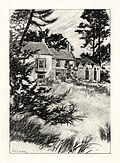Alfred, Lord Tennyson
Alfred Tennyson, 1st Baron Tennyson, FRS (6 August 1809 – 6 October 1892) was Poet Laureate of the United Kingdom in the Victorian era. He remains one of the most popular poets in the English language.
Alfred Tennyson | |
|---|---|
 1869 Carbon print by Julia Margaret Cameron | |
| Born | 6 August 1809 Somersby, Lincolnshire, England, UK |
| Died | 6 October 1892 (aged 83) Haslemere, Surrey, England |
| Resting place | Westminster Abbey |
| Occupation | Poet laureate |
Tennyson was excellent at writing short lyrics like In the valley of Cauteretz, Break, break, break, The Charge of the Light Brigade, Tears, idle tears and Crossing the Bar. Much of his verse like The Lotus Eaters was based on classical mythological themes. Tennyson also wrote some notable blank verse including Idylls of the King, Ulysses, and Tithonus. During his career, Tennyson attempted drama, but his plays were not very successful.
Red in tooth and claw
In Memoriam A.H.H. was a poem by Tennyson, written in memory of his best friend Arthur Hallam. Hallam was a fellow poet and classmate at Trinity College, Cambridge. He had been engaged to Tennyson's sister, but died from a cerebral hemorrhage before they could get married.
The poem was published after Tennyson had read a pro-evolution book by Robert Chambers. The fundamentalist idea of Biblical inerrancy was in conflict with science. Tennyson expressed the difficulties evolution raised for faith in "the truths that never can be proved".[1]
The poem is too long to quote in full, but this shows how he was thinking of the living world:
- Are God and Nature then at strife,
- That Nature lends such evil dreams?
- So careful of the type she seems,
- So careless of the single life;
- That I, considering everywhere
- Her secret meaning in her deeds,
- And finding that of fifty seeds
- She often brings but one to bear.
The much-quoted phrase comes soon after, in section 56. It refers to humanity:
- Who trusted God was love indeed
- And love Creation's final law
- Tho' Nature, red in tooth and claw
- With ravine, shriek'd against his creed.
The phrase Nature, red in tooth and claw was taken up as a metaphor for life in general, even before Darwin's Origin of species was published.
Tis better to have loved and lost...
The poem has another, perhaps even better-known stanza:
- I hold it true, whate'er befall;
- I feel it when I sorrow most;
- 'Tis better to have loved and lost
- Than never to have loved at all.
Alfred, Lord Tennyson Media
An illustration by William Edward Frank Britten showing Somersby Rectory, where Tennyson was raised and began writing
Statue of Lord Tennyson in the chapel of Trinity College, Cambridge
John William Waterhouse's The Lady of Shalott, 1888 (Tate Britain, London)
Captioned "The Poet Laureate", caricature of Tennyson in Vanity Fair, 22 July 1871
Published one year after Tennyson's death, this sketch depicts him sitting in his favourite arbour at Farringford House, his home in the village of Freshwater, Isle of Wight.
Monument to Tennyson on Tennyson Down, Isle of Wight
Stained glass at Ottawa Public Library featuring Charles Dickens, Archibald Lampman, Walter Scott, Lord Byron, Tennyson, William Shakespeare, and Thomas Moore
Break, Break, Break, on thy cold grey Stones, o Sea, a photograph by Rudolf Eickemeyer Jr. The title is a quote from the 1842 poem.
References
- ↑ Josef L. Altholz, Professor of History, University of Minnesota (1976). "The warfare of conscience with theology". The mind and art of Victorian England. Victorian Web. Retrieved 2007-11-06.
{{cite web}}: CS1 maint: multiple names: authors list (link)
2. DGM News "The Life and Works Archived 2023-03-01 at the Wayback Machine".









